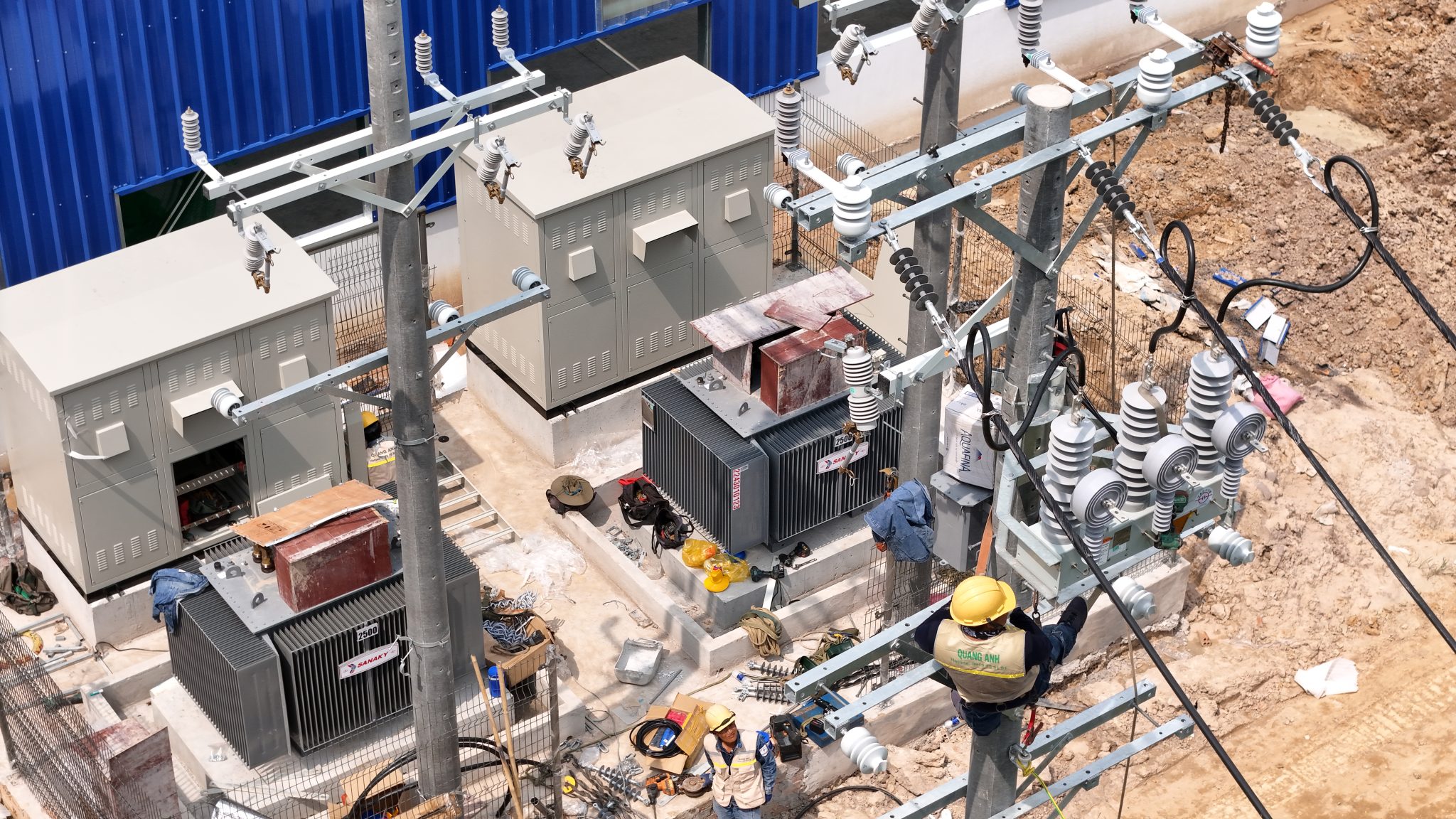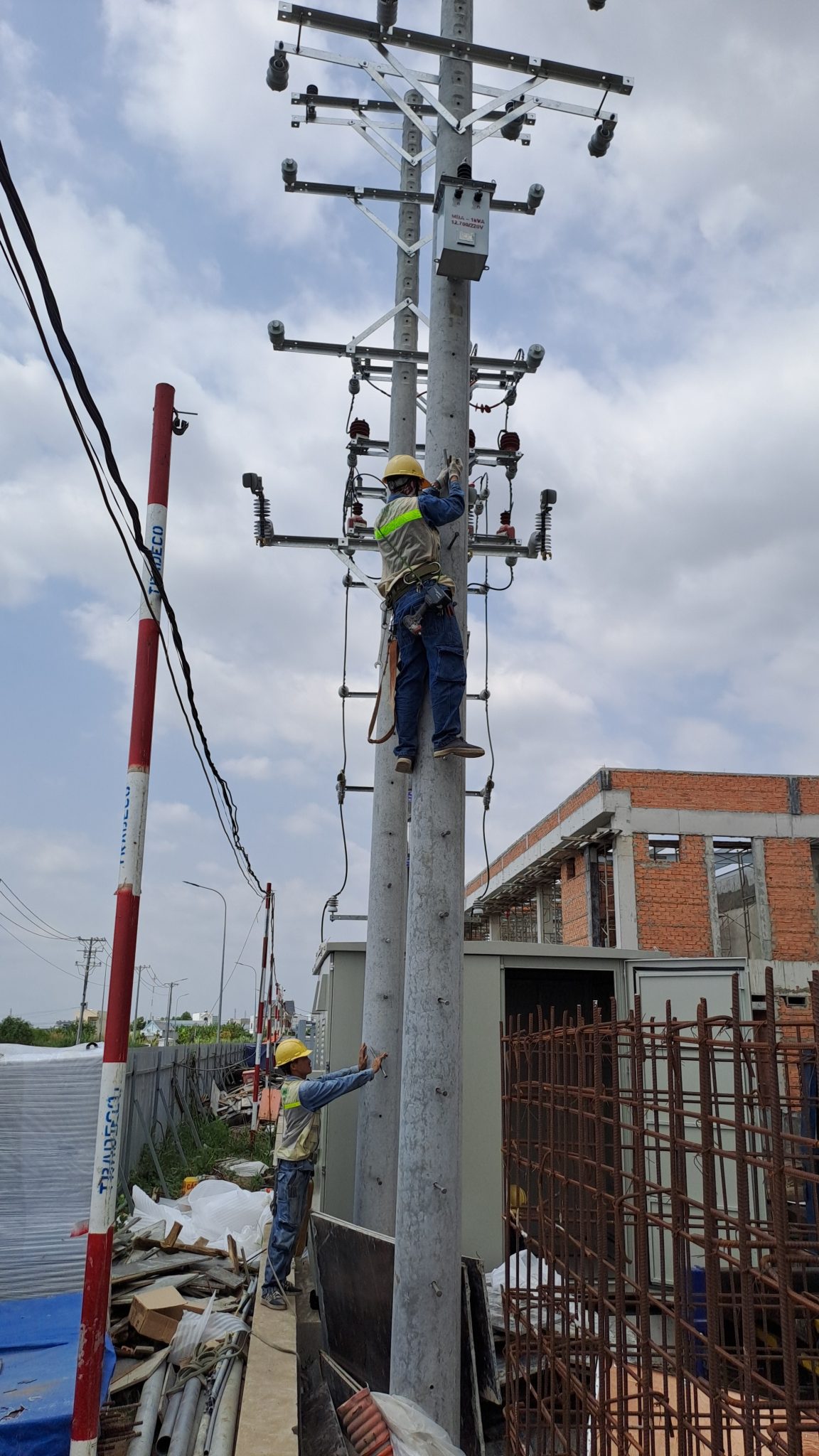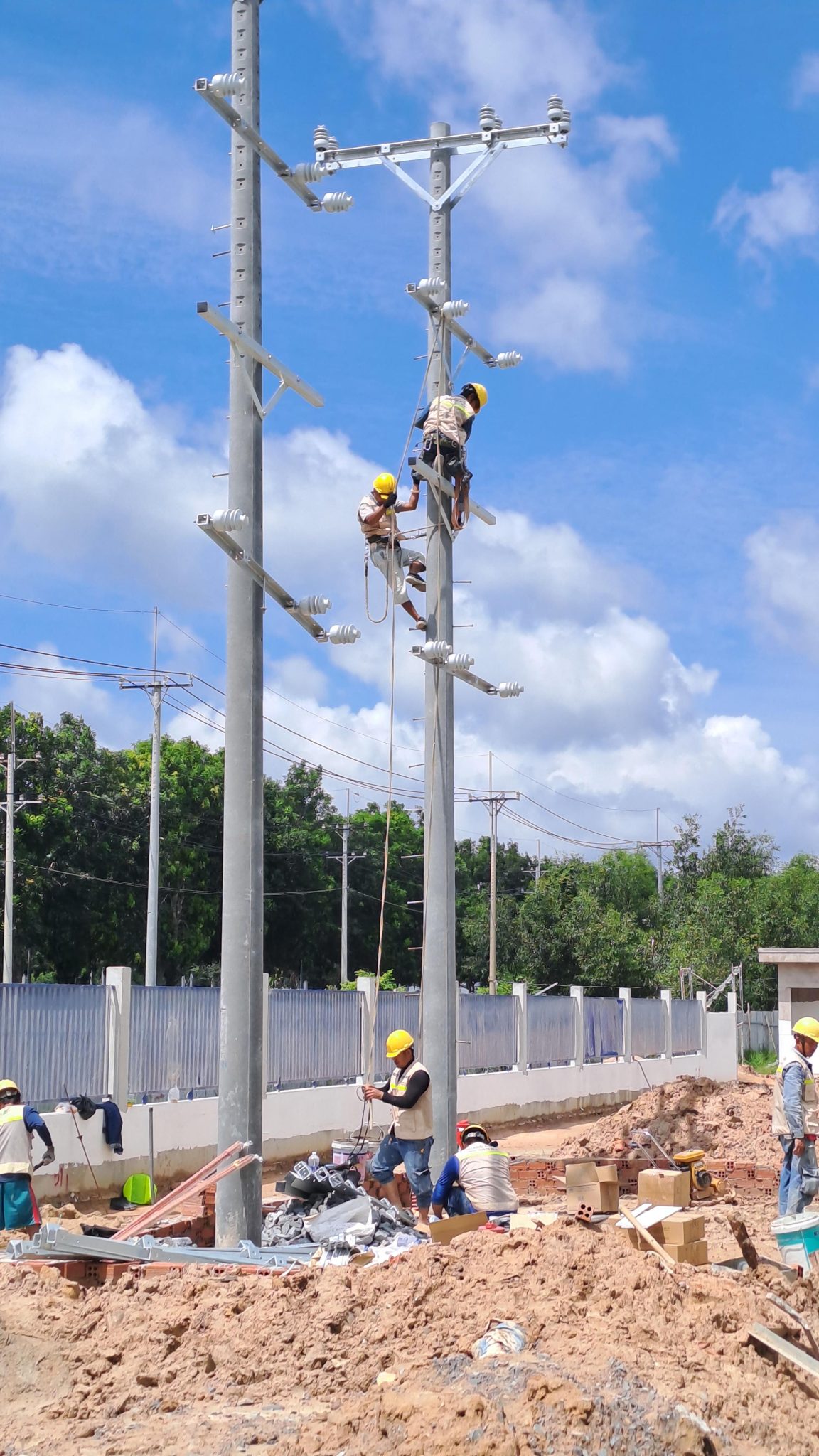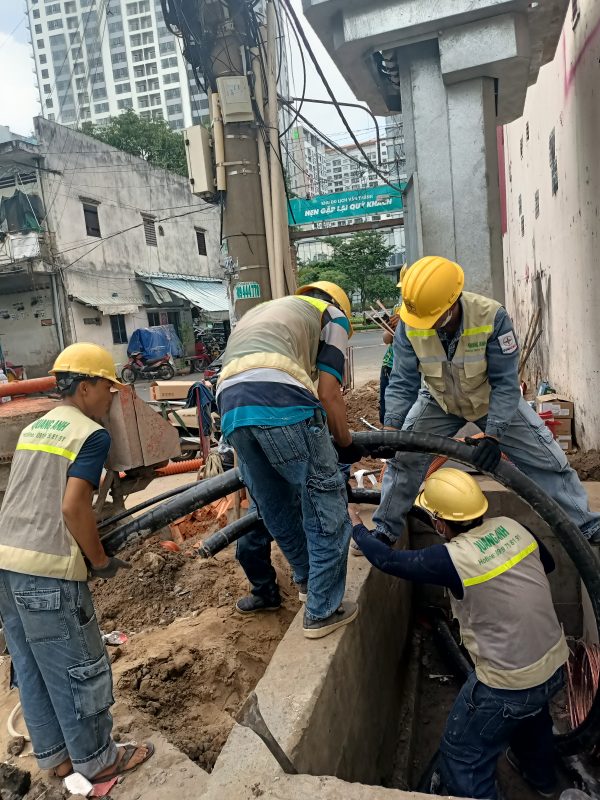Designing and implementing a factory electrical system involves creating and installing a safe and stable electrical setup for production, which includes surveying, designing, and inspection.
Design and Implementation Process
The process of designing and implementing a factory electrical system includes site surveys, detailed design of high and low voltage systems, installation of cable trays, and inspection. Each step must adhere to strict technical and safety standards to ensure stable and safe operation.
Designing and implementing an electrical system is a crucial engineering process to ensure that a project’s electrical system operates efficiently, stably, and safely. Below are the detailed steps involved in designing and implementing an electrical system.
- Project Information Gathering and Site Survey: Initially, gathering complete requirements from investors, along with a site survey, is crucial. Factors such as area, number of electrical devices, and intended use are recorded to aid in designing the electrical system.
- Preliminary Design Proposal: Based on collected information, engineers propose an initial design solution to ensure safety, aesthetics, and operational efficiency, then discuss with the investors to finalize the plan.
- Detailed Calculation and Design:
- Calculate the electrical loads to design lighting systems and sockets according to technical standards.
- Select and calculate key equipment such as transformers, generators, reactive power compensation cabinets from reputable brands like ABB, Mitsubishi, and Schneider to ensure stable operation and energy savings.
- Calculate conductors and MCCBs (automatic circuit breakers) to match the load and ensure high efficiency.
- Design grounding, earthing, and lightning protection systems meeting safety standards to protect people and equipment.
- Complete detailed design drawings for construction and inspection.
- Material and Equipment Listing: This process involves listing materials and estimating costs based on detailed designs to optimize resources for the project.
- Electrical System Implementation: Install cable trays, switchboards, and conductors following the approved design. Quality checks accompany to ensure electrical safety.
- Inspection, Testing, and Handover: Finally, the system undergoes comprehensive testing to meet safety and performance criteria before it’s handed over to the investor.
Compliance with electrical technical standards throughout these steps is vital in ensuring a safe and effective electrical system.

Detailed Design of High and Low Voltage Systems
High voltage system design involves determining pole locations and designing safe electrical networks. Low voltage systems are calculated to avoid overload and conserve energy. Emphasis on aesthetics and safety is paramount in designing cable trays.
Detailed electrical design plays a key role in ensuring the safety and efficiency of each industrial facility. For specific needs like high voltage system design, accurately determining the load is crucial. The load is the total electrical consumption capacity of all devices and machinery at a given time, helping in defining necessary technical specifications for equipment, conductors, breakers, and related components.
High voltage design, typically ranging from 35kV to 220kV, requires not only detailed layout plans from pole placement to the number of insulators per voltage level but also optimizing substation arrangement for efficient distribution. For industrial electrical systems, this is equally vital for safety and operational coordination.
For low voltage systems, with nominal voltages less than 1kV like 220/380V, priority is given to distribution and machinery control in workshops. Low voltage cables are often twisted or insulated, designed to high TCVN standards for system safety.
Steps in detailed system design include calculating load, drafting layout plans, selecting equipment, and designing efficient and safe power distribution diagrams. These steps are guided by TCVN electrical standards and must be executed by experienced technical experts.
Safety is indispensable in the design and installation process, hence lightning protection and grounding calculations are mandatory. Cable tray arrangements should be meticulously planned to ensure both aesthetics and functionality. The combination of aesthetics and technical precision ensures maximum safety for people and systems.

Installation of Cable Tray Systems
Cable trays are essential structures for protecting and organizing cables aesthetically and safely. Their installation requires sturdiness and precision, with durable materials to withstand harsh working conditions.
Introduction to Cable Tray Systems
The installation and setup of cable trays are crucial for the protection and organization of cables like electrical, signal, and network cables in constructions. The main benefits include protection from external impacts and tidy, space-savings management.
Concept and Classification of Cable Tray Systems
Cable tray systems consist of three main types:
- Cable Ladder: This type, with ladder-like design, suits structures requiring good ventilation and easy maintenance. Ideal for electrical cables in high-tech environments.
- Cable Trunking: With an enclosed base, it protects cables from dust, water, and chemicals, suitable for harsh environments or where safety is paramount.
- Cable Tray: An intermediary type between ladder and trunking, adaptable for drainage requirements or added protective covers.
Material Selection and Benefits
Wire material choice determines durability and corrosion resistance, with popular options like galvanized steel, powder-coated steel, stainless steel, and aluminum alloys.
Installation Process
- Preparation: From field surveys to determine load and working environment to detailed design drawings.
- Installation: Includes setting up support structures as per standards, linking tray sections, and legally compliant cable installations for electrical safety.
- Inspection and Acceptance: Ensure the system functions without hidden dangers and adheres to safety standards.
Technical Considerations for Installation
- Adherence to electrical, construction, and fire safety standards.
- Lightning protection and safe grounding practices.
- Material selection for corrosion resistance tailored to the working environment.
- Space allocation to prevent interference from other systems like plumbing and mechanical installations.
Standards and Regulations
Dimensions, safety, and compliance standards are critical for the efficiency and safety of cable tray systems.
Trends and New Applications
Current trends include smart cable tray systems with sensors and predictive maintenance support in smart buildings. There is also an increasing focus on using lightweight, durable, and environmentally-friendly materials.

Designing and implementing factory electrical systems not only ensures technical safety but also optimizes operational costs, contributing to the long-term sustainable development strategies of businesses.
Contact QuangAnhcons for professional advice on safe and efficient factory electrical systems design and implementation. Hotline: +84 9 1975 8191
QuangAnhcons specializes in providing comprehensive factory electrical system design and implementation services, ensuring safety, efficiency, and adherence to the technical and production needs of enterprises.


Related Posts
Factory Electrical Systems: Comprehensive Design and Implementation Guide
Discover the detailed and safe process of factory electrical systems design and implementation. [...]
Oct
Blueprints Required for Factory Construction Permits
Discover the necessary blueprints in factory construction permit applications, from floor plans to electrical and [...]
Oct
What Are the Requirements for a Factory Construction Permit? A Comprehensive Guide
Explore the documentation and steps needed to secure a factory construction permit for streamlined project [...]
Oct
Factory Construction Permit Procedures in Vietnam: Essential Guidelines and Documents
Learn the procedures for securing a factory construction permit in Vietnam, focusing on document preparation [...]
Oct
Key Steps in the Factory Construction Process
Discover the essential steps and requirements for building factories. [...]
Oct
Comprehensive Electrical Substation Solutions by Quanganhcons
Discover the cutting-edge electrical substation solutions offered by Quanganhcons for industrial applications. [...]
Oct
Investment Costs for a 1MWp Solar Power System and Influencing Factors
Explore the investment costs for a 1MWp solar power system in Vietnam and the influencing [...]
Sep
QuangAnhcons: Elevating Wind Energy Solutions
Explore QuangAnhcons' leadership in wind energy and renewable solutions in Vietnam. [...]
Sep
Electrical Contractor Strategies at Becamex Industrial Park
Discover the strategic advancements and partnerships of the electrical contractor at Becamex Industrial Park. [...]
Sep
Investment Insights for 1MW Wind Energy in Vietnam: Costs and Opportunities
Discover the detailed analysis of costs and opportunities for investing in 1MW wind energy projects [...]
Sep
Advanced Electrical Installation Solutions by QuangAnhcons
Explore advanced electrical installation solutions and modern technology with QuangAnhcons. [...]
Sep
Enhancing Industrial Electrical Services with Quanganhcons
Discover Quanganhcons' expertise in industrial electrical services, offering efficient and sustainable power systems. [...]
Sep
Comprehensive MEP Solutions by QuangAnhcons: From Design to Maintenance Excellence
Discover optimal MEP solutions with QuangAnhcons, dedicated to excellence from design through maintenance. [...]
Sep
Comprehensive Electromechanical Contracting Solutions by QuangAnhcons
Explore QuangAnhcons' comprehensive services for efficient and safe energy system solutions. [...]
Sep
QuangAnhcons: Empowering Industrial Energy Solutions
Discover how QuangAnhcons delivers optimal industrial EPC solutions. [...]
Sep
Effective Industrial Construction Management and Execution
Optimize your industrial projects from design to execution with our contractor services. [...]
Sep
QuangAnhcons: Pioneers in M&E and Renewable Energy Solutions
Discover QuangAnhcons' innovative M&E services and renewable energy solutions. [...]
Sep
QuangAnhcons: Expertise and Outstanding Services in the Electrical Sector
Discover the unmatched expertise and services of QuangAnhcons, setting superior standards in the electrical contracting [...]
Sep
QuangAnhcons: Innovation and Precision in Industrial Electrical Contracting
Discover QuangAnhcons, a top contractor offering superior electro-mechanical solutions. [...]
Aug
Expert Solutions for 2x2500kVA Substation Projects with QuangAnhCons
Explore QuangAnhCons, a forefront entity in designing and constructing large industrial substations. [...]
Aug